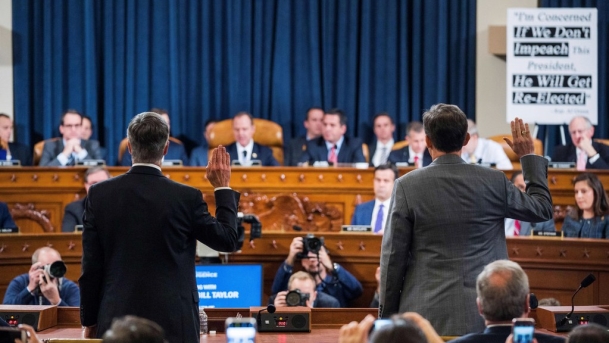
As the impeachment saga continues to pivot around Donald Trump’s presidency, Americans have been perplexed by his ability to navigate through his political battles with a sense of risking the reputation and values of the Republican Party. Some observers have argued the recent fierce debate on Capitol Hill was not simply “an impeachment inquiry into an unscrupulous president; it was the ongoing, deepening complicity and corruption of the party he leads.” (1) Peter Wehner, senior fellow at the Ethics and Public Policy Center, asserts Trump acted the way he did “should surprise exactly no one, given his disordered personality and Nietzschean ethic, his pathological lying and brutishness and bullying, and his history of personal and professional depravity. The president is a deeply damaged human being—and therefore a deeply dangerous president.” (2)
The New York Times’ Editorial Board have termed the current situation as “the Crisis of the Republican Party”, recalling McCarthyism and Senator Margaret Chase Smith’s “Declaration of Conscience”. They highlight the fact that the Party of Lincoln “is again confronting a crisis of conscience, one that has been gathering force ever since Donald Trump captured the party’s nomination in 2016. Afraid of his political influence, and delighted with his largely conservative agenda, party leaders have compromised again and again, swallowing their criticisms and tacitly if not openly endorsing presidential behavior they would have excoriated in a Democrat.” (3) Many Republicans are weighing whether Trumpism has been an asset or a liability to their party.
In this paper, Dr. Solon Simmons of George Mason University charts the development of the Republican Party narrative, using a newly developed analytical framework that he calls “Root Narrative theory”.(4) It builds on the basic intuition that the kinds of deep-rooted conflicts, which lead to ideological polarization and extended cycles of violence and misunderstanding are propelled by rival interpretations of the abuse of power. Simmons notices these images of abusive power are woven into larger stories of injustice that take on their own momentum, structuring identity formation, becoming incorporated into coherent worldviews of deep commitment, and furnishing world-shaping political parties with grammars of political meaning that can be combined in endlessly creative ways. This paper will be published in two parts.
In a letter dated October 9, 2019, U.S. president Donald Trump responded to the threat of a Turkish incursion into northern Syria by the Turkish president Recep Tayyip Erdogan with the following words: “History will look upon you favorably if you get this done the right and humane way. It will look upon you forever as the devil if good things don't happen. Don't be a tough guy. Don't be a fool!" said Trump.” (5)
It is unclear what the goal of the letter was, although its effect was clear enough. Just days into the military offensive launched by the Turkish military into Kurdish territory, Gulnur Aybet, senior adviser to Erdogan, provided an interview in which she described how the letter was received. “Look. It was a leaked, old letter, which was not taken seriously at the time, especially given its lack of diplomatic finesse. And the response to that letter was the start of the operation. And now, the U.S. delegation that came to Ankara yesterday and the ones that are here today are addressing the situation one week after we started the operation. So we've really moved on considerably since this letter was said. It's absolutely irrelevant.” (6)
Trump reportedly reacted in an Oval Office meeting with Italian President Sergio Mattarella on October 16 by attacking his former Secretary of Defense who had refused to concede northern Syria to the Turks, accusing General James Mattis of being “not tough enough,” and bragging, “I captured ISIS. Mattis said it would take two years. I captured them in one month.” (7)
It was clear in this episode that American power had changed with its transition into the twenty-first century. American power continued to be projected around the world as it had since World War II, but it was no longer respected in the way it had been. The President of Turkey could throw a direct American threat to his country into the trash. Along the way, the American civil discourse had been attenuated to almost cartoonish levels of simplification, and the Republican Party, begun as a reaction to the abusive power of the nineteenth century system of slavery, had become something wholly different. Where the party had once stood for human rights, economic liberty, and domestic stability (8), now it was a global agent promoting a novel worldview that pundits could only describe as unprecedented. The party was no longer the party of nostalgia, baseball and apple pie. Donald Trump had broken that old spell, even if he was only putting into motion forces that had been in motion at least since the heartbreak since Vietnam. (9)
 |
| Trump’s Leaked Letter to Erdogan [Reuters] |
Even if these forces had been at work for some time, the changes they wrought had never struck at the heart of the American story as the Trump transformation has done. To see an American leader kowtow to authoritarian counter-pressure in Syria made it clear to even members of the hawkish wing of the Republican Party that these ideological changes might soon to undermine the seven decades of tense stability of the post-World War II period, the so-called Pax Americana. The shock was that the intellectual revolution that might well permanently humble American power was one of the right, not the left. Although the Democratic Party is the obvious candidate for what Ralph Waldo Emerson called “the party of innovation,” as it happens, in foreign affairs it was the Democrats who were the conservatives and the Republicans the radicals. The narrative of global politics had changed and it was the Republican Party who had changed it.
As we trace the contours of history, it is common to follow the progress of nations, cultures or leaders, but the modern era has been as much shaped by powerful coalitions of actors within nations as it has by the nations themselves. The English Whigs, The Russian Bolsheviks, The Chinese Communists, and now the American Republic Party have left their marks on global history. These parties were held together by common interests, and also by shared convictions, but most of all they were carried along by a narrative.
The story structures that propelled these constellations of actors into common purpose are the stuff of which history is made, and such fields of purpose cannot be turned except from within. Any hope we have for progress in human affairs depends on our ability to work with this narrative, the categories of the moral imagination, that is widely held by these parties, and insofar as the Republican Party of the United States has become a threat to global stability, it is essential to help the party to rediscover its purpose in terms that are compatible with world peace and global progress.
New stories can be told that fit the political realities that the parties are prepared to accept. Old momentum can be turned in new directions through ideological pivots and development. Synergies across divides can be predicated on the facts of existing worldviews. Even if you are a bitter critic of the Republican Party and can’t wait to celebrate its demise, given its position in the command posts of the major institutional hierarchies of global power, it is exactly this sort of transformation that anyone in the world, from the leftist radical of the global south to hidebound traditionalist of the gated community of the Western metropole, needs the party to go through.
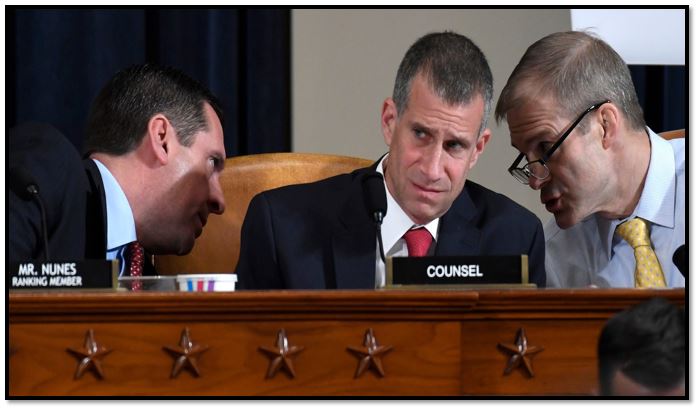 |
| Rep. Devin Nunes, the ranking member on the House Intelligence Committee; Steve Castor, a Republican staff attorney for the House Oversight and Reform Committee; and Rep. Jim Jordan [AP] [Unspecifeid] |
What are Root Narratives? The Twelve Stories
Root Narrative theory provides a very simple way to represent the complex phenomenon through which parties to conflict pull together heterogeneous political realities into a coherent worldview. Root narratives are the primitive stories that a person would tell who was reflecting on the negative consequences of the use of a form of social power. Because it is possible to reduce the forms of social power to a very small number of separable forms, it is also possible to reduce the number of root narratives to a correspondingly small number. There are as many root narratives as there are forms of social power. Although it has been one of the signal challenges of sociology to develop such a typology of forms of social power, the Weberian and neo-Weberian models remain central (10), even with the elaborations on the nature of power that have been developed by Michel Foucault, Steven Lukes and others. (11)
These elaborations speak to the nature of power and its application but do not change the neo-Weberian forms themselves, which describe features of our institutionalized experience that produce adverse consequences. Although later theorists of power have helped us to see how subtle its workings are, a Weberian interpretation of power retains its narrative force by being understood as “power over,” even though most concrete examinations of power reveal its nature as a different kind of force: “power to,” power with,” etc (12). Power is as productive a thing as it is destructive. Without modern means, we would be condemned to lives, nasty brutish and short. But while there is a positive aspect to the productive solidarity of narrative-driven social power, just as often it exacerbates ongoing conflicts and perpetuates confusion and social suffering.
We can distinguish social power into four forms: military, political, economic, and cultural. These are a version of the four forms identified by the sociologist Michael Mann. (13) Military and political power correspond to Weber’s conception of what he called “party.” Economic and interpersonal power correspond to what he describes as class and status, respectively. Class and status are often confused with one another, but speak to very different aspects of social life. Class or economic power is more about what you have, while status or interpersonal power is about who you are. Both forms of power derive from social experience and can be used and abused by those who hold them.
All four forms of power produce identities based on binary distinctions between those who use and those who abuse the various forms of power, but status speaks in language closest to what we often describe as the politics of identity or recognition. Cultural identity and psychological identity are not the same thing. There are as many politically-relevant psychological identities as there are forms of power to define them; cultural identity is only one of those forms of power.
 |
| Simmons's recent book [Routledge] |
None of the four forms of power, military, political, economic, cultural is found present in isolation; power comes in a package. Military, political, economic, and cultural forms are commonly intermingled in a single act or episode of social life. It is hard to know when one form ends and the other begins. This difficulty is reflected in the complex stories that people tell about events and episodes in political life and conflict. Two people can witness the same event, see the same ‘fact’ and tell very different kinds of stories about it. On close inspection, research demonstrates that they do so by relying on different root narratives, which identify different antagonists, different abuses, different injustices, and different protagonists. Their stories identify the political realities of abuse of power and the need to check it, which can be arranged into the root narrative structure. Most conflict accounts combine some complex array of root narratives in any single instance, which means that they are best represented with a profile.
In order to build the profile, it is necessary to develop its elements. (14) These are the root narratives themselves. In order to generate a full list of the root narratives, it is necessary to cross the four root narratives that correspond to the four forms of social power with each other. This is because the meaning of the stories of abusive power people tell inflect one another, introducing subtle distinctions in interpretation.
In this way, the root narrative Foreigners use armed violence to create physical deprivation in the State, developed in opposition to the abuse of military power can be combined with another one that develops in reaction to abuse of economic power, Elites use bargaining power to create unfair competition for the People, to create a hybrid root narrative, Elites use bargaining power to create physical deprivation in the State—what I call the Unity Narrative. The protagonist function of the security narrative has been combined with the antagonist of the equality narrative to create a new kind of securitarian story, one that is quite commonly used, that implies that divisive elements in the leadership of our society are abusing their privilege for personal gain at the expense of our lives and well-being. This procedure can be repeated in all the implied combinations to produce the following list of twelve root narratives.
 |
| Tom Steyer, leader of the impeachment movement [Getty] |
You can immediately see the advantage of the theory like this one. It allows the analyst to represent the political reality of any party to conflict with an array of simple stories that can be represented with a profile. It is a theory for the measurement of political realities. The theory can be thought of as a structural theory in the tradition of continental social philosophy, and also as a performative theory in the sense that the root narratives are only effective insofar as they are put into use and associated with people and events in the empirical world.
The Political Realities of the Modern Republican Party
The great advantage of narrative theories of politics is there capacity to transcend the various paralyzing dualisms that have distracted political theory for generations (15). Although some scholars use the narrative concept to promote a merely idiographic approach, that emphasizes emotion, embodiment, and the particular over the general, storytelling is the synthetic function that brings these together with reason, theory, and the general. In this view, we only have access to the events of conflict through the stories that people tell about them. Therefore, the best use of the concept of narrative is to transcend these dualisms in pursuit of what has been called substantive reason (16).
Narrative is the vehicle of the imagination that provides us access to reality as it manifests to us. By analyzing the stories that politicians tell about the political world, we can gain access to what they represent as their political realities, which is a better use of the term realism than is typical of conversations in the international relations literature. Through root narratives, we get at the root causes of the conflict as the parties to the conflict are ready to accept them.
When we examine the accounts of political reality revealed by leaders of the Republican Party over the past century, it is clear that even though there are certain points of continuity, there have been important changes in the political worldview of the party in the period of American ascendance. The best way to see this is to examine a consistent data source over the period of examination. One useful source is the speech that a candidate for president for the Republican Party presidential nomination delivers to the national convention. The convention speech can be thought of as the initial sales job for the candidate and reveals what he hopes members of his party want to hear as they gear up for the push toward the November election.
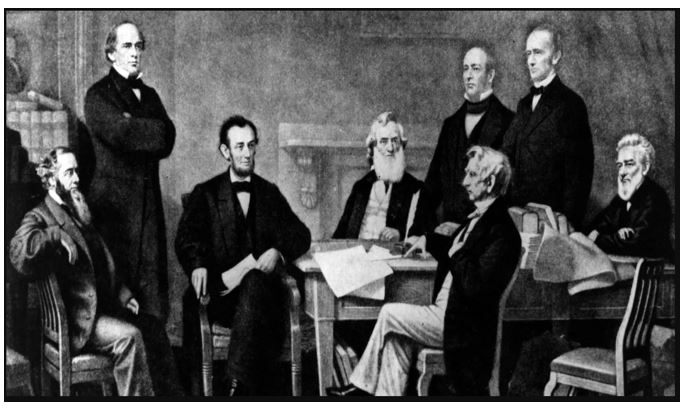 |
| Abraham Lincoln, the 16th President of the United States of America, at the signing of the Emancipation Proclamation [Getty] [Getty Images] |
This type of setting is important for Root Narrative theory, because it has immense potential when applied to earnest public speeches. Much like a forensic expert would extract DNA from a cast of drinking cup the theory can pick up traces of political worldview from any discourse (written or spoken) that the analyst believes the author wants his audience to believe. Insofar as a speaker is using language that he thinks his audience most wants to hear, we can assume that the root narrative profile of the speech reveals the rough outline of the effective root narrative profile of the party in that moment. Therefore, we can learn a lot about ideological change in the Republican Party by observing how these national convention speeches have changed over time. To limit attention to the most salient and earnest speeches, I will only analyze the first speech of a successful Republican candidate, that is one who won the presidency. This limits the sample to Republican National Convention acceptance speeches from the years 1920, 1928, 1952, 1968, 1980, 1988, 2000, and 2016. These eight pronouncements capture the most important Republican leaders at their most important moments of ascent.
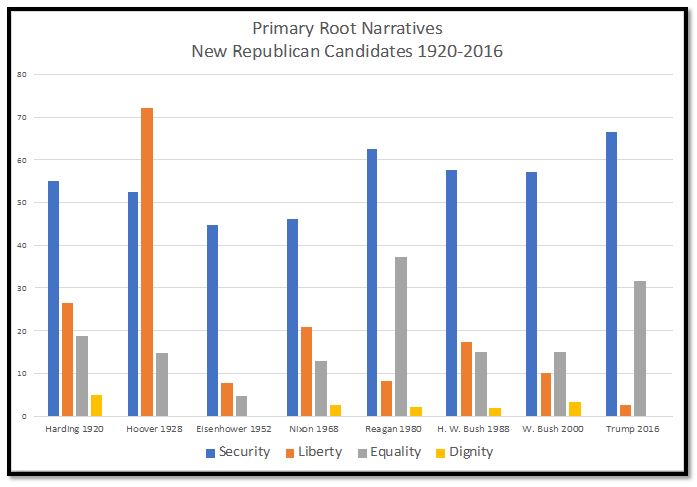 |
| By the author |
First, consider the root narrative profiles of the nine speeches at the four-category level. In Figure 1, above, we can see how important the value of security is for Republicans over the full period of the study. The lowest reading is in 1952 when Eisenhower first ran for the office. Only 45% of his speech employed securitarian elements. It is also interesting to note that his former vice president, Richard Nixon had a similar profile, coming in at 46%. In contrast, Donald Trump at 66% has the highest securitarian rating of all nine presidents, only rivaled by Ronald Reagan at 63%.
We also see how the value of liberty has fallen away in Republican discourse. In 1928, Herbert Hoover presents a kind of outlier with 72% of his speech using libertarian references, but even so, Donald Trump’s speech had the lowest level of libertarian elements of all nine of the speeches. Finally, the more recent speeches have played with egalitarian elements, those that stress the interests and rights of the people vis-à-vis some sort of privileged elite. Both Reagan and, to a lesser extent Trump, used egalitarian themes in their convention speeches much more than the other Republican aspirants.
These narrative gaps are easier to see in Figure 2, which portrays the difference between the portion of the speech using the theme from the average proportion for all nine cases. In Figure 2 we see how distinctive the early twentieth century was with respect the libertarian imagination, how relatively non-ideological the middle part of the century was in the Eisenhower/Nixon years, and how important some blend of securitarian/egalitarian themes has been in the period the rise of the conservative intellectual movement and the Trump victory.
 |
| By the author |
The four-category root narrative profile gives us significant insight into the moral imagination of the Republican Party over time period and shows us some of the ways it has changed. It conforms to some rough ideas we might have about what it is that moves American conservatives and how they might relate to conflict. We can see the deep history of the commitment to liberty, even as it has faded in use over the century, and how a turn to egalitarian rhetoric coincides with the rise of the Reagan Democrats or the white working-class voter of Donald Trump. Nevertheless, the four-category profile conceals as much as it reveals; it does not show us how revolutionary the Republican Party has become and where it might look to reform itself if it hopes to climb out from the hole it has dug for itself in global affairs.
To get a better sense of the subtle changes in Republican rhetoric, we can use data from the twelve-category root narrative profile. The clearest signal of narrative transformation in the Republican Party is with the primary root narrative of the security category. As stated above, the story runs, Foreigners use armed violence to create physical deprivation in the State.
This is a fairly common type of story to tell in politics and might well represent the primal narrative of politics, but it has been a relatively small part of Republican Party discourse—until now. We can see the evidence for this in Figure 3. No doubt, Republicans have been long been willing to speak of foreign threats and the need to counter them, but only Ronald Reagan had dedicated as much as 20% of his convention speech to the topic, and that at the height of the Cold War. Donald Trump more than doubled Reagan’s tally and used much more strident language in making his claims as well.
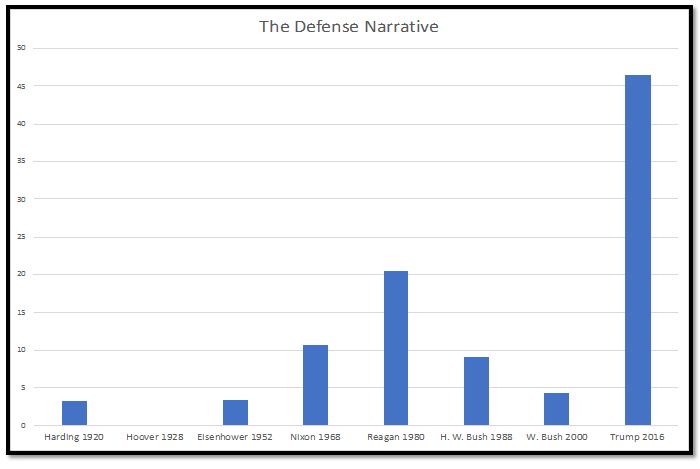 |
| By the author |
The difference in context in which Trump made his defensive claims is important to note, because unlike Nixon, Trump was striving for office without a major foreign enemy to contest. The nation had been engaged in the Global War on Terror for almost two decades, but Trump’s foreign threats were as likely to appear as migrants as combatants. Trump’s use of the aggressive Defense Narrative was a new turn in Republican Party rhetoric and a major signal of where the party has lost its way. Stability was always at the heart of the American ethos; at his funeral, George Washington had been celebrated as, “first in war, first in peace, and first in the hearts of his countrymen.” Always concerned with its stability, the America of the right had tended to place the accent on liberty rather than security. As the proto-Republican John Quincy Adams had written, “she goes not abroad, in search of monsters to destroy.” Under Donald Trump the Republican Party had found a way to deploy the long-standing securitarian imagination of the Republican electorate to search out the enemies he was willing to imagine in ways that none of his predecessors had.
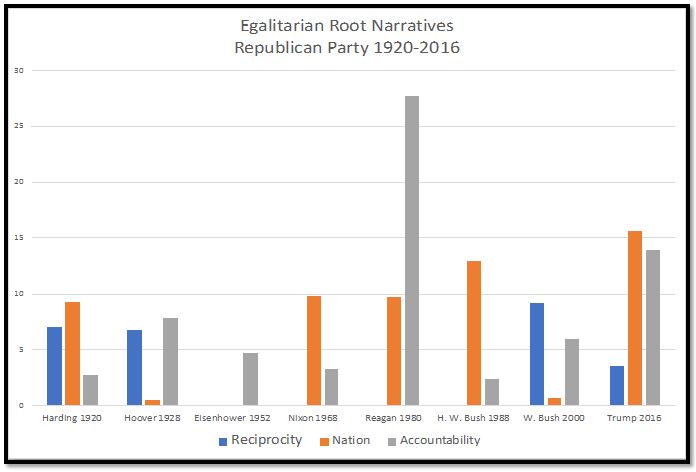 |
| By the author |
It is also important to play closer attention to how the concept of equality was being used in Republican Party rhetoric. This can be seen in Figure 4 above. Keep in mind that the primary egalitarian story has a socialist flavor. The root narrative is, Elites use bargaining power to create unfair competition for the People. The obvious solution in this story is for the people to redistribute the bargaining power so that they might have a fair opportunity to pursue their interests in the marketplace in their competition with the rich. Although not absent in their rhetoric, especially in the build-up to the Great Depression, this is not how the Republican Party tapped into the egalitarian consciousness of the American people. Instead, really beginning with Ronald Reagan, they turned the narrative against the government itself, employing what is called an accountability narrative in Root Narrative theory, a secondary root narrative on the major egalitarian theme. The root narrative borrows the villain from the consent narrative and runs, Governments use force of law to create unfair competition for the People. In this story arc, it is the government that is cheating the people, usually through taxation and wasteful spending. Although the story type can be helpful when governments have become hopelessly corrupt, it is unlikely to help if and when the main problem facing the working people and middle classes is the bargaining power of the wealthy.
A similar transformation holds for the other egalitarian root narrative, Foreigners use armed violence to create unfair competition for the People. While this story structure, called the Nation Narrative in Root Narrative Theory, usually softens the image of abusive power so that it appears as something like “threats of force” or even “pressure tactics,” the central idea is that the American people are being cheated or outmaneuvered by foreigners who do not have their best interests at heart. The Nation narrative is a powerful part of the overall Republican story, and has been for some time. After all, it was Warren Harding who introduced the rhetoric of “America first.” Nevertheless, it is little surprise that Trump used it more in his speech than had any of his predecessors. The family resemblance of this narrative with the Defense Narrative through the antagonist line is strong (both are opposed to foreign villains) and voters who might be inclined towards socialism might be able to identify with the protagonist of this story in the plight of the beleaguered people. If foreigners are out to cheat us, perhaps we needn’t worry so much about the corporations.
To get an overall sense of how the narrative of the Republican Party had transformed over the so-called “American Century,” that period after the United States had taken a leadership position in the international community, it is useful to compare three points of reference: 1928, 1980, and 2016. The Republican Party convention speeches for these three years is depicted in Figure 5.
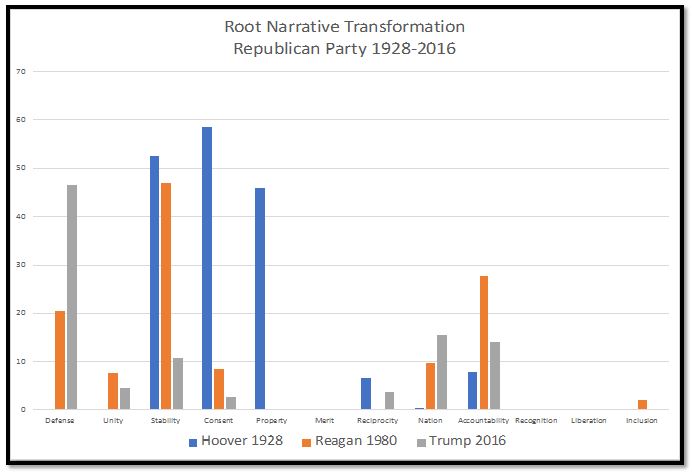 |
| By the author |
As stated above, it is clear in this figure that Security has always been important to the party but that concern has shifted from a focus on general stability to ward off chaos to concern to protecting Americans from hostile foreigners. We also see that the classical liberal concerns for the consent of the governed and the rights of property owners have fallen away in dramatic fashion form the liberal heights of the 1920s. Finally, in a point that might be obvious, the party of Lincoln has little to say about the plight of the marginalized, and victims of discrimination. These concerns, while once the province of the Republicans, are now part of the Democrat’s story.
Part 2 of this paper will be published soon.
-
Peter Wehner, “The Exposure of the Republican Party”, The Atlantic, November 13, 2019 https://www.theatlantic.com/ideas/archive/2019/11/trumps-republican-party-built-lies/601990/
-
Ibid,
-
Editorial Board, “The Crisis of the Republican Party”, The New York Times, October 18, 2019 https://www.nytimes.com/2019/10/18/opinion/trump-impeachment-republicans.html
-
Simmons, Solon. 2019. “The Root Narrative Profile: The Power of Story for Reputation Management.” (Unpublished Manuscript), and Simmons, Solon. 2020. Root Narrative Theory and Conflict Resolution: Power, Justice, and Values. Routledge Studies in Peace and Conflict Resolution. London: Routledge.
-
Santora, Marc. 2019. “Turkish President Slams Trump’s Letter for ‘Lack of Respect.’” The New York Times, October 18, 2019, sec. World. https://www.nytimes.com/2019/10/18/world/europe/trump-erdogan-letter.html.
-
Inskeep, Steve. 2019. “Erdogan Adviser On Turkey’s Attacks In Syria.” NPR Morning Edition. https://www.npr.org/2019/10/17/770848622/erdogan-adviser-on-turkeys-attacks-in-syria.
-
Suebsaeng, Sam Stein|Asawin. 2019. “Trump Rages at Pelosi and Mattis in White House ‘Meltdown.’” The Daily Beast, October 16, 2019, sec. politics. https://www.thedailybeast.com/trump-rages-at-pelosi-mattis-isis-escapees-and-communists-during-meltdown-in-white-house-syria-meeting.
-
Gerring, John. 1998. Party Ideologies in America 1828-1996. Cambridge: Cambridge University Press.
-
See Edwards, Lee. 1999. The Conservative Revolution: The Movement That Remade America. New York: The Free Press; Perlstein, Rick. 2008. Nixonland: The Rise of a President and the Fracturing of America. 1st ed. Scribner; and Simmons, Solon. 2013. The Eclipse of Equality: Arguing America on Meet the Press. Stanford, California: Stanford University Press.
-
Weber, Max. 1978. Economy and Society. Edited by Claus Wittich. Vol. 2nd. Berkeley: University of California Press.
-
Foucault, Michel. 1995. Discipline & Punish: The Birth of the Prison. Vintage, and Lukes, Steven. 2005. Power: A Radical View. 2nd ed. Palgrave Macmillan.
-
VeneKlasen, Lisa, Valerie Miller, Debbie Budlender, and Cindy Clark. 2002. A New Weave of Power, People & Politics: The Action Guide for Advocacy and Citizen Participation. World Neighbors Oklahoma City.
-
See Mills, C. Wright. 1956. The Power Elite. New York: Oxford University Press, Giddens, Anthony. 1987. The Nation-State and Violence. Berkeley, CA: University of California Press. Mann, Michael. 1986. The Sources of Social Power: A History of Power from the Beginning to A. D. 1760. Cambridge: Cambridge University Press, and Mann, Michael. 2008. “Infrastructural Power Revisited.” Studies in Comparative International Development 43 (3–4): 355.
-
Simmons, Solon. 2020. Root Narrative Theory and Conflict Resolution: Power, Justice, and Values. Routledge Studies in Peace and Conflict Resolution. London: Routledge.
-
Fisher, Walter R. 1985. “The Narrative Paradigm: In the Beginning.” Journal of Communication 35 (4): 74–89, and Cobb, Sara. 2013. “Narrative Braiding and the Role of Public Officials in Transforming the Publics Conflicts.” Narrative and Conflict: Explorations in Theory and Practice 1 (1): 4. https://doi.org/10.13021/G8TG65
-
Jay, Martin. 2016. Reason after Its Eclipse: On Late Critical Theory. University of Wisconsin Pres.